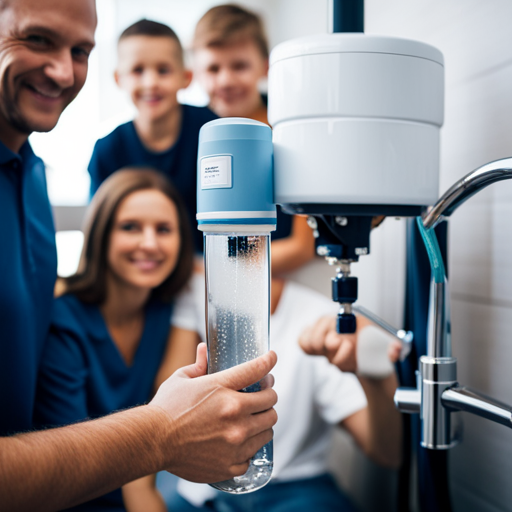Are you tired of dealing with hard water in your home? The constant buildup of mineral deposits in your pipes and appliances can be frustrating and costly. But fear not, with the right tools and some basic plumbing skills, you can install a water softener in your home and enjoy the benefits of soft water.
In this article, we’ll guide you through the process of installing a water softener yourself. We’ll provide you with tips and insights on how to avoid common mistakes and ensure a successful installation.
By the end of this article, you’ll have all the knowledge you need to tackle this moderately difficult DIY project and improve the quality of your drinking water, benefit your skin and hair, and save money on maintenance costs.
Let’s get started on your journey to a soft water, happy home.
Key Takeaways
– Installing a water softener is a moderately difficult DIY project that requires plumbing skills, special tools, and 4 to 8 hours.
– It is best to install the water softener at the point where water enters the house to prevent scale build-ups in pipes and plumbing structure by removing minerals.
– Water loops keep water softened and direct it to water-consuming appliances. If the house already has a water loop, the installation is easy.
– Benefits of water softeners include softer skin and hair, less soap scum, longer-lasting appliances, and saving money and reducing maintenance costs.
Installation Basics
If you’re planning to install a water softener, you’ll need to have basic plumbing skills and special tools as it’s a moderately difficult DIY project that takes 4 to 8 hours. Choosing the right location is also crucial, as the best place to install a water softener is at the point where water enters your home.
This is where the water loop starts, which directs the water to all the water-consuming appliances in your house. If your house already has a water loop, installation is easy. However, if not, you’ll need to create one, which can be a bit more challenging.
Before starting the installation process, make sure that you have all the necessary tools and materials at hand. These include a pipe cutter, wrenches, PVC glue, and Teflon tape. You should also check the owner’s manual for any specific tools or materials that are needed for your water softener model.
Additionally, it’s important to choose a level and accessible spot for your water softener, as this will make future maintenance and repairs easier.
Mistakes to Avoid
To avoid mistakes during installation, make sure you choose the right-sized water softener, fittings, and connections, and avoid using too many sources or placing the drain hose incorrectly. Here are some common mistakes to avoid:
1. Choosing the wrong-sized water softener can lead to insufficient water softening or wasted water and salt. Make sure to measure the hardness of your water and calculate the appropriate size for your household.
2. Using the wrong fittings and connections can cause leaks and damage to your plumbing system. Double-check the compatibility of your water softener with your existing pipes and fittings.
3. Using too many sources can overload your water softener and reduce its effectiveness. Limit the number of water sources connected to your water softener to ensure optimal performance.
4. Placing the drain hose incorrectly can cause backflow and flooding. Follow the manufacturer’s instructions for proper placement and installation of the drain hose.
By avoiding these mistakes, you can ensure a successful installation and enjoy the benefits of soft water in your home. Remember to consult the owner’s manual and seek professional help if needed for a smooth installation process.
Benefits of Water Softeners
You can save money and reduce maintenance costs while improving your drinking water quality by installing a water softener. Not only will you have softer skin and hair, but you’ll also experience less soap scum and longer-lasting appliances.
Additionally, water softeners help protect the environment by eliminating the need for chlorine, which can have harmful effects on aquatic life.
Improved water quality is one of the main benefits of having a water softener. Hard water can contain minerals such as calcium and magnesium, which can cause scale build-ups in pipes and plumbing structures. Soft water, on the other hand, is free from these minerals and can extend the life of your water-consuming appliances.
By reducing the amount of scale build-up, you’ll also have better water pressure and less clogging. With all these benefits, it’s easy to see why installing a water softener is a smart investment for your home.
Conclusion
In conclusion, installing a water softener in your home can be a great way to improve the quality of your drinking water and reduce maintenance costs in the long run. With the right tools and basic plumbing skills, you can tackle this moderately difficult DIY project and enjoy the benefits of soft water.
Remember to follow the installation basics, such as choosing the right location and connecting the water softener to the main water supply line, and avoid common mistakes, such as using the wrong type of fittings or failing to properly flush the system.
Some of the key benefits of water softeners include reducing scale build-ups in pipes and plumbing structures, improving the efficiency of appliances, and even benefiting your skin and hair. By removing minerals that cause hard water, you can also enjoy cleaner dishes, softer laundry, and a more comfortable showering experience.
So, if you’re ready to take on this project, follow these DIY water softener installation tips and enjoy the benefits of soft water in your happy home!




